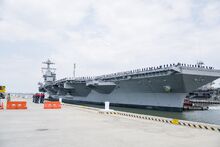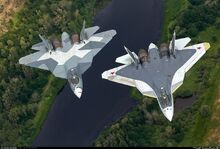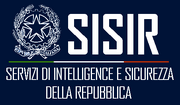| Istalian Republic Repubblica Istaliana | |||||
|---|---|---|---|---|---|
| |||||
  Flag Coat of Arms Flag Coat of Arms
| |||||
| Anthem Fratelli d'Istalia | |||||

| |||||
| Capital Romula | |||||
| Languages Istalian | |||||
| Demonym Fidelian (official), Majatran, Trivenditan, Feranese, Nicomese, Cisavuglian (spoken) | |||||
| Government Parliamentary Presidential Semi-Presidential President of the Republic First Enrico Bergson Last Al-Khaid Sebastiano President of the Council Prime Minister (4490-4546) First Romano Poldi Last Elio Santamaria | |||||
| Legislature Parliament of the Republic | |||||
| Area 669.600 km² | |||||
| Population 137,400,000 (4403) | |||||
| Currency Lira | |||||
The Fourth Istalian Republic, officially only Istalian Republic, Repubblica Istaliana in Istalian (Majatran: إستاليا and الجمهورية الإستالية, transl. as 'iistalia and aljumhuriat al'iistalia), was the democratic republic which preceeded the establishment of the Fifth Istalian Republic. With 1182 years of existence, it has been the longest lasting democratic republican regime in the Istalian history and also, probably, the most renowned and powerful.
The historians traditionally have distinguished an Old and a New Fourth Italian Republic, with the brief Battistian regime dividing it in two periods of about 500 years each. If for most part of the Old Fourth Republic the Istalian Governments were mainly focused on the domestic affairs with little if none international involvements, if not as a partner within pan-continental organization with, however, limited partecipation, the New one saw Istalia rising among the most powerful nation all over the world, imposing a great international influence mainly between the 41th and the 45th century, arriving to be the most influential nation in Majatra with a thriving continental and international economy which granted to its citizens some of the best life-styles worldwide.
Istalia was involved on the international affairs as never previously during the New Fourth Republic, thorugh political-diplomatic and economic agreements established with most part of the nations of Terra, especially with the other great powers, but also building an impressive military apparatus which granted to the country the power to project its force virtually all over the world.
History[]
See also the Foreign Affairs section for an historical overview about the international involvements and the foreign policies adopted by the Fourth Republic.
Geography[]
Politics[]
Government[]
The Fourth Istalian Republic was since its foundation a democratic, secular and unitary republic which government system, however, was reformed several time during its existence. For the first half of its existence, under the so called Old Fourth Republic, Istalia was organized for most part of the time as a parliamentary government but it was interested by not less than seven presidential reform which, however, lasted always for few years.
Decisively more successful was the Semi-Presidential reform adopted in 4133: it lasted for 143 years without notable changement and was the government system which was in force for all the so called New Fourth Republic.
Being organized into a semi-presidential system, the Republic had as Head of State, directly elected by the citizens with a two round majority system, a strong President of the Republic with important political powers who, as well as representing the Nation, preserving its unity and integrity and acting as guarantor of the Consitution and of the Institutional regime, had the possibility to assume also the veritable role of Head of Government sharing the powers with the President of the Council of Ministers, the Prime Minister of the Republic since 4490, appointed by the President with the other Ministers on advice of the Prime Minister himself.
Together with the Cabinet and the Head of Government, the President led Istalia's executive but its degree of influence depended by the composition of the Chamber of Deputies, the Houses which had to approve the proposed Government throught a vote of confiance: if the party or coalition which supported the elected President gained the majority, the appointment of a Prime Minister from the President's majority party or coalition granted to the the Head of State a strong leadership of the Executive; but in the case the parliamentary majority was controlled by an opposite party or coalition, the President acted as a figurehead of the State leaving to the Prime Minister the effective executive powers so to act as full Head of Government like into a Parliamentary System.
The Legislature of Istalia, unicameral under the Old Fourth Republic, was instead bicameral and composed by the Chamber of Deputies and the Senate of the Republic under the semi-presidential regime.
Political parties[]
The Fourth Republic has been the longest lasting democratic regime which Istalia ever knew, interrupted just for less than 6 years by the Battistian regime. Like for the other republican regime, a multi-party system was ensured by the Constitution. The general political culture, furthermore, due to the traditionally highly fragmented political landscape, tendentially pushed so that the parties joined larger political coalition to assure major stability to the governments. A "two-coalition system" charaterized most part of the years of the Republic, with most part of the coalitions clashing on economical and social issues mainly.
Judiciary[]
The Judiciary under the Fourth Republic was articolated in a system of national and regional courts which provided three judicial degrees. At the top of the Judiciary there were three main bodies: the Supreme Tribunal of Cassation (Istalian: Tribunale Supremo di Cassazione) for civil and criminal affairs, the Supreme Court (Istalian: Corte Suprema) for the constitutional review of laws and other measures adopted by the State and their institutions, and the Council of State for the administrative justice. The Istalian Constitution granted special constitutional rules and protections to assure the indipendency of the Judiciary.
Law enforcement[]
Law enforcement under the Fourth Republic was provided by multiple police forces, three of which were national agencies. The Polizia di Stato della Repubblica (State Police of the Republic) was the civil national police of Istalia and the main police force of the Country. Along with patrolling, investigative and law enforcement duties, it patrols the Rete Autostradale Istaliana (Istalia Express Highway network), oversaw the security of railways, bridges and waterways and it was also responsible of the customs.
The Gendarmeria Nazionale della Repubblica (National Gendarmery of the Republic) was a Gendarmerie-like military corps with police duties which jurisdiction extended mainly in the countryside and little towns of Istalia. They also served as the military police for the Istalian armed forces.
The Polizia Finanziaria della Repubblica (Financial Police of the Republic), finally, was a militarized police force under the authority of the Minister of Finance which was essentially responsible for dealing with financial and economic crime and smuggling.
Foreign Affairs[]
Istalia, under the Old Fourth Republic privileged and adopted a diplomatic and cooperative approach to the foreign policy, aimed to work within supernational organizations like the Majatra Union which Istalia joined and supported for a peacefull Majatra and to promote economic integration, having the Pan-Majatranism always charaterized the foreign policy of the Fourth Republic, probably one of the few Quanzarian policies retained by the re-established democratic order. However, due to the moderate economic, military and political influence internationally, it remained always a secondary actor privileging neutrality and avoiding to be involved in army conflicts or military ventures.
Under the New Fourth Republic, instead, backed by a rapidly growing global economy and increasingly powerful armed forces, Istalia asserted even more its influence. When the World Congress was established and the first elections for the five nation to become members of the Security Council were organized, Istalia launched an impressive worldwide campaign to convince the Governments of as many countries as possible to chose Istalia on the basis of democratic principles and values promoted by the country and actually it was a success: Istalia in 4113 joined the Security Council of the World Congress achieving then to be always re-elected until the reform which established the four most powerful countries of Terra, and Istalia was one of them, as permanent members of the Council. Istalia remained within the Security Council until 4510 when the World Congress officially recognized the downgraded international status of the country following the crisis of 45th century.
The years between the beginning of 42th and the half of 45th century were certainly the most successful for the Istalian foreign policy, firmly imposing itself as one of the major power of Terra and one of the most influential nation worldwide. The Istalian Republic during his tenure within the Security Council Istalia became the strongest supporter of a pro-democratic stance by the World Congress and even more interventionist against serious human rights violations. Istalia was behind the creation of some major World Congress agencies such the Anti-Slavery Office. Thanks to its activity within the Congress, Istalia gained the reputation of one of the most fierce opponents to anti-democratic, dictatorial, suprematist regimes.
As worldwide power, Istalia obviously achieved to establish important relations and alliance with other powers and nations through bilateral agreements or entering in several international organization aimed to common defence and security. Notable was the 4175's agreement between Istalia and Luthori to found a new Organization of Collective Security and Cooperation to superseed the previous one. The new Organization attracted the most part of the democratic powers and among them also Kazulia, becoming for a while the most powerful military alliance of the world. However, due to the decline of the influence of Luthori, which turned in Republic and reduced greatly its international activities, and the increasing complicated relations between Istalia and Kazulia, which, became probably the two most powerful nation of Terra, clashed for the greatest worldwide influence, the organization finally became inaffective and progressively most part of the nations had left it around the end of 43th century.
In the meantime the influence of Istalia was increasing first of all in Majatra, where Istalia had already established a 50-year long lasting military alliance with Solentia and then began to intervene more often and also with more incisiviness all over the continet. One of the most important intervention was the one in the at the time Area commonly known as Kalopia-Wantuni, the no-government and no-state entity in which the previous Kalopian Republic fell in 4129. Became a no-man's land, most part of the country fell under the authority of warlords, ethnic tribal communities (especially in the south) and private corporations. The slavery also was reintroduced became affair mainly of the infamous well known Eilomax corporation. Istalia intervened in the west of the country to defend the deep interests established there by many Istalian corporations and to contrast the slavery after the national companies were accused of profiting on slavery. It was then established a protectorate, alongside the one created by Kazulia, then reformed into the Federal Republic of Kalopia-Wantuni an important ally for Istalia during the next century.

Istalia (dark green) and the other members of the Majatran Alliance (light green) in 4403
In fact, in 4213 was founded the Majatran Revolutionary Socialist Federation, a super-state which unified Jelbania, Deltaria, the territories controlled by the socialist government of Kalopia-Wantuni and Jakania. Istalia, as International power and first of all regional leader with many continental interests, was the one that arose as main opponent of the socialist superstate, to contrast which Istalia promoted the foundation of a new supranational organization among the free and democratic nations of Majatra begining to stregthen the relations with one of the other most powerful and advanced nations of the continent, first of all Zardugal, with which an Alliance and Common Economic Area was established to integrate the respective economies and markets and to become the larger and most dynamic economic area of the world. The project then was enlarged and in 4222 Istalia began to promote the Majatran Alliance, modelled on the alliance with Zardugal, but aimed to unite the other democratic nations of Majatra so to contrast economically and diplomatically the socialist superstate, as well as to create a solid military alliance to contrast it. The Alliance, however, was also aimed to contrast the never dimmed hegemonic aspirantion of Vanuku which never conceiled its committment to contrast the other majatran powers, first of all the Istalian's raising start, also arriving to establish a no aggression treaty with the MRSF. The alliance, however, was successful, and with the progressive decadence of the socialist regimes in the second half of the century the Majatran Alliance expanded to other nations (among them Pontesi, Eastern Kalopia, Deltaria, and Beiteynu) and the founder member began to push for the establishment of even more common programs and colaborations, also to fight the cronical instability of the continent.
Establish a peacefull and integrated continent continue to be the main objective of Istalia in this period and the 4260's Thallerist invasion, or the arrival of members of the Thaller family in Majatran to exploit the caos and the political weakness of several post-MRSF nations to establish new thallerist regimes, pushed Istalia to get closer to the nation which was its main adversary for more than a century, Vanuku, with which was formed an alliance to contrast the foreign menaces and influence on the continent. The thallers where contrasted in most part of the countries, achieving to maintain the power only in Deltaria where, however, was established a more democratic government which conducted also peaceful relations with Istalia.
The 44th century began with Istalia involved in the Hulstrian Civil War which saw for the first time in history Istalia and Vanuku cooperated on the field. The common concerns about the foreign menaces and influences on Majatra finally pushed the two countries to reach an agreement. Vanuku joined the Majatra Alliance and the so called Temerkai-Votta Pax was established, a period of peace and prosperity for the whole continent driven by the two continental powers which lasted until the begin of 45th century, favorited also by the fall of another adversary regime of Istalia, the Yeudish suprematist regime in Beiteynu.
The 45th century, however, represented a century of challenges and great trouble for Istalia, prompted mainly by the crisis the Majatran Alliance will experience in this century. The crisis for the Alliance blowed up when it proved to be impotent in solving the crisis between Deltaria and Vanuku, both members of the Alliance, engulfed in the Jelbék Civil war (4408-4424), aiming both to estend their control on the unstable central majatran nation. When Vanuku launched its nuclear attack against the Deltarian forces in Jelbania, Istalia found itself really isolated, forced to condamn the Vanuku's actions but which tried to maintain good relations with.
Many other majatran nations perceived the weakness of the Alliance and, sick of the Vanuku-Istalian "dictate" and unsatisfied by the proposed reform of the Alliance presented by Istalia, leading by Cildania they founed a new majatran organization, the Majatran Union of Nations. Istalia agreed with Cildania to enter in the MUN but remaining into the Alliance, hoping to be able to integrate the two organization: Istalia, wanted extend its influence also within the new Union, but being more than an Alliance and closer to a supernational government, the influence of single nations were not so determining toward the elective Grand Assembly and President of the MUN. The Black Thursday, however, perceived as caused by the troubling Alliance and the decreased role of Istalia into the MUN, pushed many to regret to be entered into the MUN: the Governments in the middle of the century decided to leave the MUN, also because a socialist coup happened in Deltaria establishing a new socialist regime which was accused by Istalia to want to reduce the MUN.
Promoting once again a reformed Majatran Alliance, Istalia tried to assert its influence partecipating in the war in defence of Cobura from the aggresion by part of the Zardic Augustine Empire and also entering into the delicate Jelbanian situation supporting the coastal cities of the Free Democratic Republic and opposing Deltaria and its puppet state of the Southern Jelbanian Khanate.
The terroristic wave which interested Istalia in the second half of the century, however, diminished once again the Istalian attention to the international affairs and despite the political forces was able to contrast it, domestically as well as abroad, a new crisis focused all the attention of the country: the far-rightist Solentia was, in fact, evolving in a veritable fascist regime which caused the breack of the relations with Istalia which, however, was forced to contrast a large migration crisis from Solentia due to the even more repressive regime.
The general political decline of the country of the end of the century, the lack of skilled politicians and governments interested in the foreign affairs, then another economic crisis due to the loss of ground on international markets at the beginning of the 46th, finally, drastically decreased the influence of the country, formally degraded by most part of the ranking agencies and institutions already in the 80's of 45th century, which didn't represented any more a global but only a regional international actor which effectiveness, however, was very limited due to the great internal crisis which affected also the large military expenses of the country.
Defence[]
Military[]

The nuclear aircraft supercarrier NP 649 Fortezza, flag ship of the Istalian Navy, one of the most advanced of its kind worldwide
The Istalian Armed Forces for the first half of the Fourth Republic were mainly focused on the defence of the territories and as such, it lacked of means aimed specifically to project its forces abroad and to pursue mission worldwide. In the other hand, the newly established Republic, as said, opted for a diplomatic and cooperative approach to the foreign policy. Furthermore, the Old Fourth Republic was always contrary to the nuclear weapons, also because a nuclear arsenal was a objective of the previous Quanzarian dominion, and in fact, despite the nuclear prolification in many close countries, the Republic prohibited almost constantly the Armed Forces to have nuclear or biological weapons. For all these reason, the first 5 centuries of the Fourth Republic didn't see large military involvements and also the defence industry didn't was so developed, often under state ownership, and large part of the military equipements came from abroad.
All changed in 41th century after the Battistian regime: with the establishing of the New Fourth Republic, mainly on impulse of President Alessandro Senna, the Istalian Armed Forces undertook the most extensive and radical reform of Istalia's defense, privileging first of all the domestic industries which were widely supported by the state which aimed to develop the technological know-how of the country. President Senna, and the following Governments, indeed, changed radically the foreign policy of Istalia, became even more internationalistic, expanding the sphere of national interest globally, aimed to be able to project its forces far from the national borders. The nation changed also its position on the nuclear weapons starting to develop its arsenal and become in the following 50 years a Nuclear triad power.
Since the end of the 42nd century, with the increased international position of Istalia, the Istalian Armed Forces became one of the largest, most advanced and powerful of all Terra, counting almost 600,000 personnel on active duty while the Ministry of Defence employed just over 100,000 civilians. As per the doctrine introduced by the new international interests of the country, important quotas of the Defense funds were reserved to the Research and Development Department of the Defence to assure to the Armed Forces the best equipements and capabilities and their constant improvement and upgrade. The President of the Republic were the commander-in-chief of the nation's armed forces and as Chairman of the Supreme National Security Council, he had a great deal of discretionary power in appointing the Ministry of Defense and also in appointing the Armed forces leaders, in particularly the Chief of Defence Staff, whose appointments formally belongs to the Ministry of Defence. Military service for most part of this period was voluntary, though conscription may occur in wartime. During the 43th and 44th century, as global power, established also several military base abroad (among the main ones the Base in Costa de Oro, Baltusia, which was one of the closer allies of Istalia for 200 years, and another one in the southern shores of Malivia, since the middle of 43rd century became another important ally of Istalia. Thanks to these bases and especially thanks to its Navy, the Istalian Republic became fully able to project its force virtually all over the world.

Two F-43 Falco, the last generation air superiority aircraft fighter of Istalia
Intelligence[]

Logo of the SISIR
The community which formed the istalian intelligence services, also known as Servizi Segreti (luthorian: Secret Services), was officially known as Intelligence and Security Services of the Istalian Republic (istalian: Servizi di Intelligence e Sicurezza della Repubblica) (acronym: SISIR) and were formed by several departments and agencies like the DESIS, the Department which oversaw the national intelligence, the AISIR and the AISER, the two agencies responsible respectively of domestic and foreign intelligence, and several department depending by the Armed Forces.
Administrative division[]

Administrative map of Istalia
The Fourth Istalian Republic maintained the traditional and historical five administrative divisions called Regions (Istalian: Regioni), three on the Peninsula, Mezzodiurno, Padagna and Trivendito, and two on Alaria, Sarregna and Silicia.
In turn, the Regions were sub-divided into Provinces (Istalian: Province), four each region, named after their capitals.
Finally, the Municipalities (Istalian: Comuni) were the last and smallest administrative divisions under the Provinces, which administered cities, towns and villages.
About the Government of the administrative sub-entities of Istalia, while the Provinces were mere territorial sub-divisions with no government bodies but only some administrative powers, delegated to the Provinces by the Regions at their discretion, Regions and Municipalities had elective bodies in the form of Regional and Municipal Councils and monocratic executives like the Governors (Governatori) for the Regions and the Mayors (Sindaci) for the Municipalities.
Economy[]

The Terran Global Financial Center in Romula
The istalian economy for the first half of the existence of the Fourth Republic remained mainly focused on the national market were the foreign multinational corporations had large presence due the fact that istalian companies were not able to adeguately compete outside the national borders. However, thanks the long lasting stability of the country and absence of events like wars, revolutions, uprisings, etc... which instead interested most mart of the other majatran countries, Istalia was able to assure a developed and quite advanced society, with salaries and life style always well above the majatran average. Istalia during this period trade mainly with the closest nations of east majatra and south seleya.
The last 500 years circa of the Fourth Republic, however, saw the country progressively emerge to arose among the global economic powers. The internationalistic stance of the new era increased vertiginously the trade with the rest of the world while business-friendly policies and investments in research, education and industry improved the istalian competitiveness. The Istalian economy, like all other developed economy, focused mainly on the tertiary sector and so on advanced services and worldwide trade. The heavy industry focused on the most advanced technology while the oil and gas industry expanded both for the exploitment of the Perartic Ocean's deposits and the decline of many other historical worlwide petroleum companies. The manufacturing and agricultural sectors, mostly consisting of small and medium-size enterprises, however, didn't was forgotten and instead they were promoted worldwide becoming renowned for high quality and luxury products. It exported mainly primary services and high-tech products, oil and gas and an important role is representing also by the arms export. Being one of the Terra's economic powers, Istalia housed some of the most advanced and larger corporations worldwide,

Famous luxury goods manufactured in Istalia
among them Magistro-Leonardi S.A., Hasan-Mariani Holding & Investement Group, Enist, Estal, Hasan Aeductus World Shipping, Istelecom S.p.A., Oliverdi, TerraMedia, OTO Al-Mehara Armamenti, Umana Servizi, Farilla and so on (see also about the Istalian Corporations to know more). This economic success granted to the Istalian citizens one of the highest life style worldwide.
Demographics[]
Population[]
As of 4545, there were 99,800,000 people residing in Istalia. The most populated city was Romula with 13 million of people. Since the end of 43th century Istalia became a multicultural nation, attracting people all over the world and becoming an immigration nation.
Ethnicity[]

Typical Istalians
If under the first half of its existence the Fourth Istalian Republic was a rather homogeneous ethnically nation, with two large and distinct groups: the Istalians (80% circa) and the Majatrans (20% circa). Under the previous Third Quanzarian restoration, there were also many solentians, almost a third of the population, concentrated in the northern regions of the Peninsula who, after the definitive defeat of the Quanzars, profered to leave in mass the country where they were seen as a heritage of the foreign dominion.
When instead in 41th century the Country was on the way to become a great economy, many from Majatra and then from the rest of the world started to be attracted by the opportunities offered by the growing country which maintained also predominantly pro-immigration policies for most part of the following centuries. In 4545, ethnic istalians represented 71% of the total residents, the 13% belonged to the Majatran ethnicity while almost 16% of total residents where immigrated or descendant from immagrated.
Most part of the immigrates and of their descendants came from Majatran nations, first of all Solentia and from the most close allies of Istalia. Interesting was the Saridanese community, formed by refugees of the several segretionist regimes established in the Seleyan country. It was a population which was missing its traditional homogeneity and was becoming even more multi-ethnic, attracting, as said, people all over the world due to the large economy and developed society and also to long lasting pro-immigration policies.
| Nations of Majatra | |
|
| |
